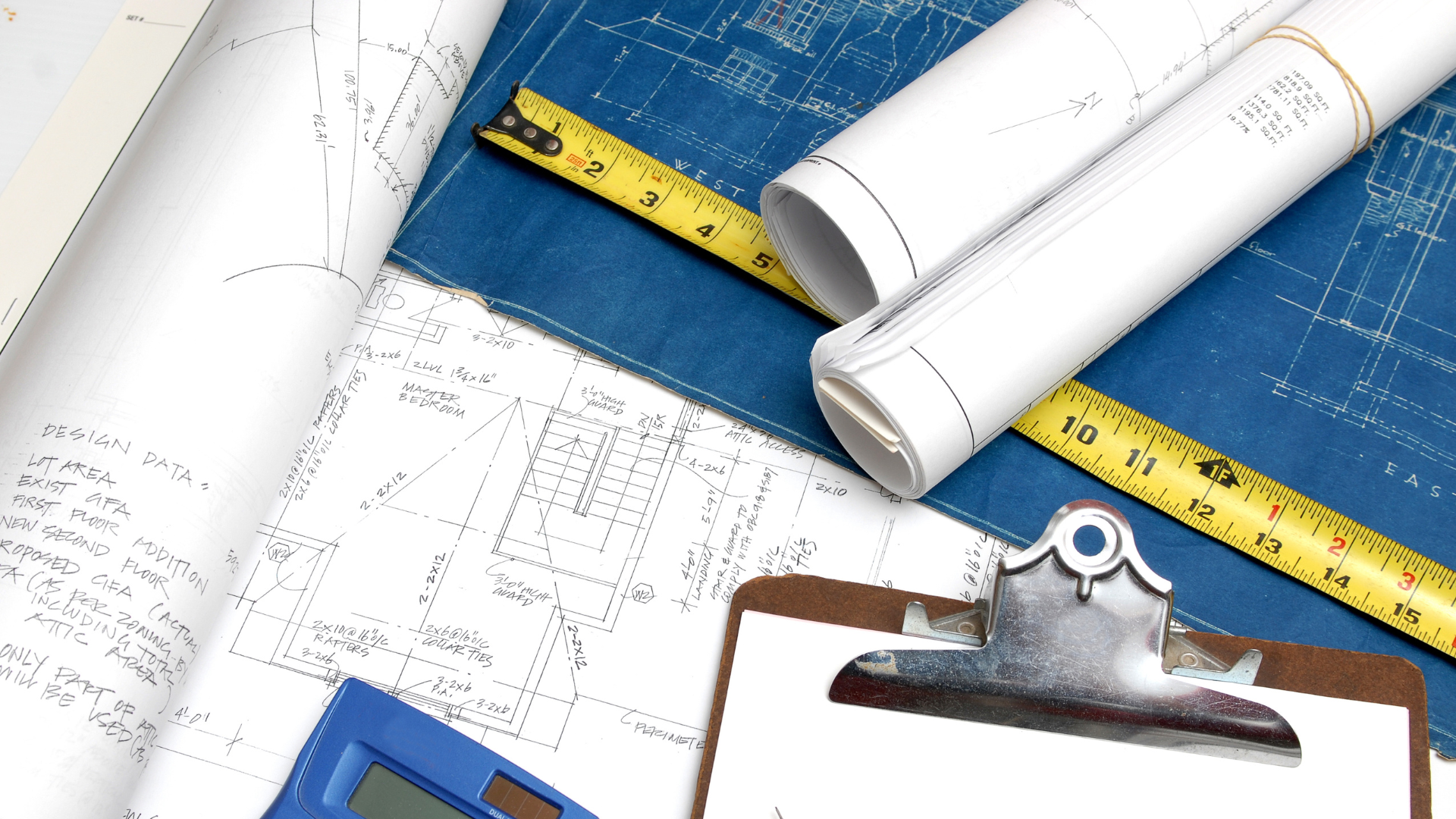Ever heard the phrase: “Failing to plan is planning to fail”?
In the construction business, poor forecasting doesn’t just mean stress; it means real money lost.
According to a McKinsey report, large construction projects typically take 20% longer to finish and run up to 80% over budget. That’s a painful statistic every general contractor, office manager, project manager, and estimator can relate to.
Accurate forecasting is the backbone of successful construction project management. Without it, small mistakes in scheduling or cost estimation can snowball into massive budget blowouts, project delays, and sleepless nights.
But here’s the good news: modern construction project management software is changing the game for forecasting, giving construction companies the tools they need to stay ahead of risks and keep projects profitable.
How can contractors improve their forecasting for construction projects by using construction software?
In construction, even the smallest miscalculation in labor hours, material costs, or subcontractor schedules can spiral into expensive setbacks.
This blog will help you understand why construction project management software steps in as a safety net. Instead of relying on spreadsheets or guesswork, contractors, office managers, and estimators can use forecasting tools to:
- Track costs and labor in real time
- Compare estimates with actuals throughout the project lifecycle
- Spot risks early and adjust schedules or budgets before problems snowball
- Keep project documents, accounting, and service management connected in one place
Forecasting with digital tools isn’t just a trend; it’s proving results:
- 71% of contractors using construction forecasting software reported better cost control.
- 64% experienced fewer schedule overruns, thanks to real-time tracking and updates.
- Companies adopting integrated forecasting, accounting, and service management saw measurable improvements in both back office operations and field coordination.
These numbers make it clear: contractors who embrace modern tools are not just managing projects, but are building long-term profitability.
Key Takeaways
- Accurate forecasting reduces costly overruns and project delays.
- Construction project management software gives contractors visibility across budgets, schedules, and resources.
- Centralizing project documents, accounting, and service management helps project teams stay aligned.
- Whether for a construction company or a small construction business, software-driven forecasting leads to increased profitability and efficiency.
What is Construction Project Forecasting?
Think of forecasting as your project’s weather report. It doesn’t just tell you what’s happening now, it predicts what’s coming next so you can prepare.
In construction, forecasting is the ongoing process of predicting future project costs, schedules, and resources based on current data and trends.
Unlike budgeting, which is usually done once at the start of the project lifecycle, forecasting is continuous; it adjusts as projects progress, surprises happen, and change orders pile up.
Why does this matter? Because construction is rarely static. Forecasting ensures you’re not caught off guard when unexpected costs or delays show up, allowing builders, subcontractors, and project teams to stay aligned.
Key Forecasting Tools Used in Construction Project Management Software
1. Earned Value Management (EVM)
EVM sounds technical, but let’s simplify it: it’s like your project’s fitness tracker. It shows how much work you’ve done, how much you planned to do, and what it cost you.
- Planned Value (PV): What you are expected to complete by now.
- Earned Value (EV): What you’ve actually completed.
- Actual Cost (AC): What you’ve actually spent.
By comparing these numbers, project managers can see if they’re ahead or behind schedule and budget. Spotting these variances early means you can fix issues before they spiral, which is crucial for service management and back office operations.
2. Cost-to-Complete Forecasting
Imagine you’re on a road trip with half a tank of gas. The question is: Will it be enough to reach your destination? That’s exactly what cost-to-complete forecasting does: it estimates the remaining expenses based on progress so far and trends ahead.
This helps construction companies avoid nasty surprises near project completion when money runs out, but work doesn’t. It also helps accounting teams provide accurate cash flow predictions for better decision-making.
Also read: Construction Cash Flow Management for Projects Made Easy
How Modern Construction Software Supports Forecasting
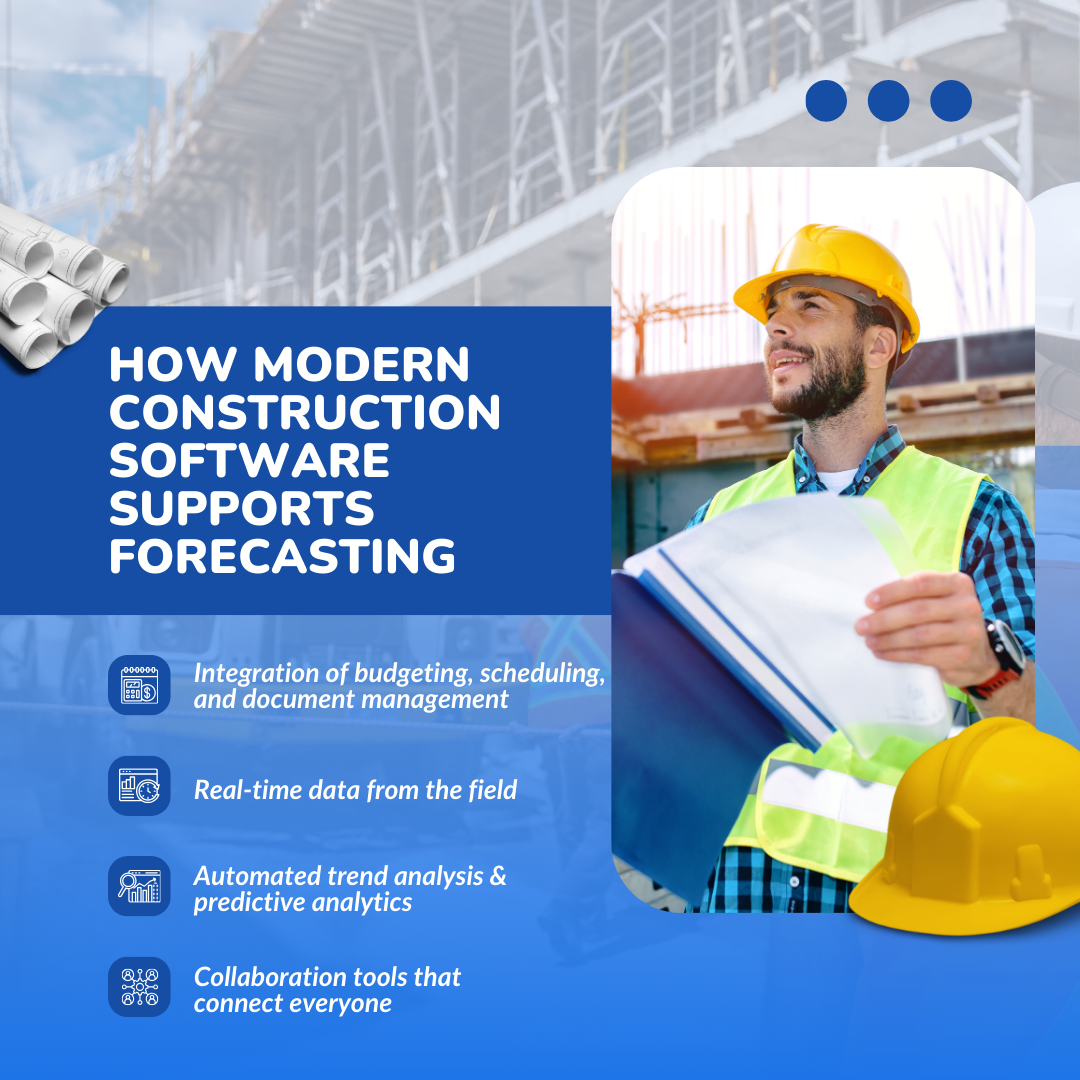
Modern construction management software isn’t just a digital spreadsheet; it’s the backbone that keeps projects running smoothly. Instead of contractors juggling separate tools for costs, schedules, and documents, software ties everything together into one integrated system.
The result? Less guesswork, more clarity, and smoother project delivery.
Here’s how it helps:
1. Integration of budgeting, scheduling, and document management
No more wasting time switching between apps or digging through emails for the latest numbers. Forecasting tools bring budgets, schedules, and project documents under one roof.
That means project managers, office managers, and subcontractors can view the same data in real time, avoiding costly miscommunication.
2. Real-time data from the field
Daily logs, service management updates, and change orders don’t just sit on paper; they flow directly into the system.
Field teams update progress, and office managers see it instantly. This real-time sync ensures forecasts are based on what’s actually happening, not outdated assumptions.
3. Automated trend analysis & predictive analytics
Software does the heavy lifting by analyzing data patterns and spotting risks early. For example, if labor hours are trending above plan, the system flags it before it snowballs into a budget issue.
Predictive analytics gives contractors the confidence to act proactively instead of reactively.
4. Collaboration tools that connect everyone
Construction projects run on teamwork. With shared dashboards and communication tools, project managers, specialty contractors, site supervisors, and financial officers stay on the same page. Fewer crossed wires mean smoother workflows and stronger project outcomes.
Solutions like Construction Management Software platforms are built specifically for the construction industry.
They don’t just make projects easier to manage; they directly support profitability by streamlining back office operations, reducing rework, and helping contractors forecast with precision.
Take a deeper insight at: Construction Project Management Software for Construction Teams: A 2025 Overview
Common Forecasting Challenges Contractors Face (and How Software Helps)
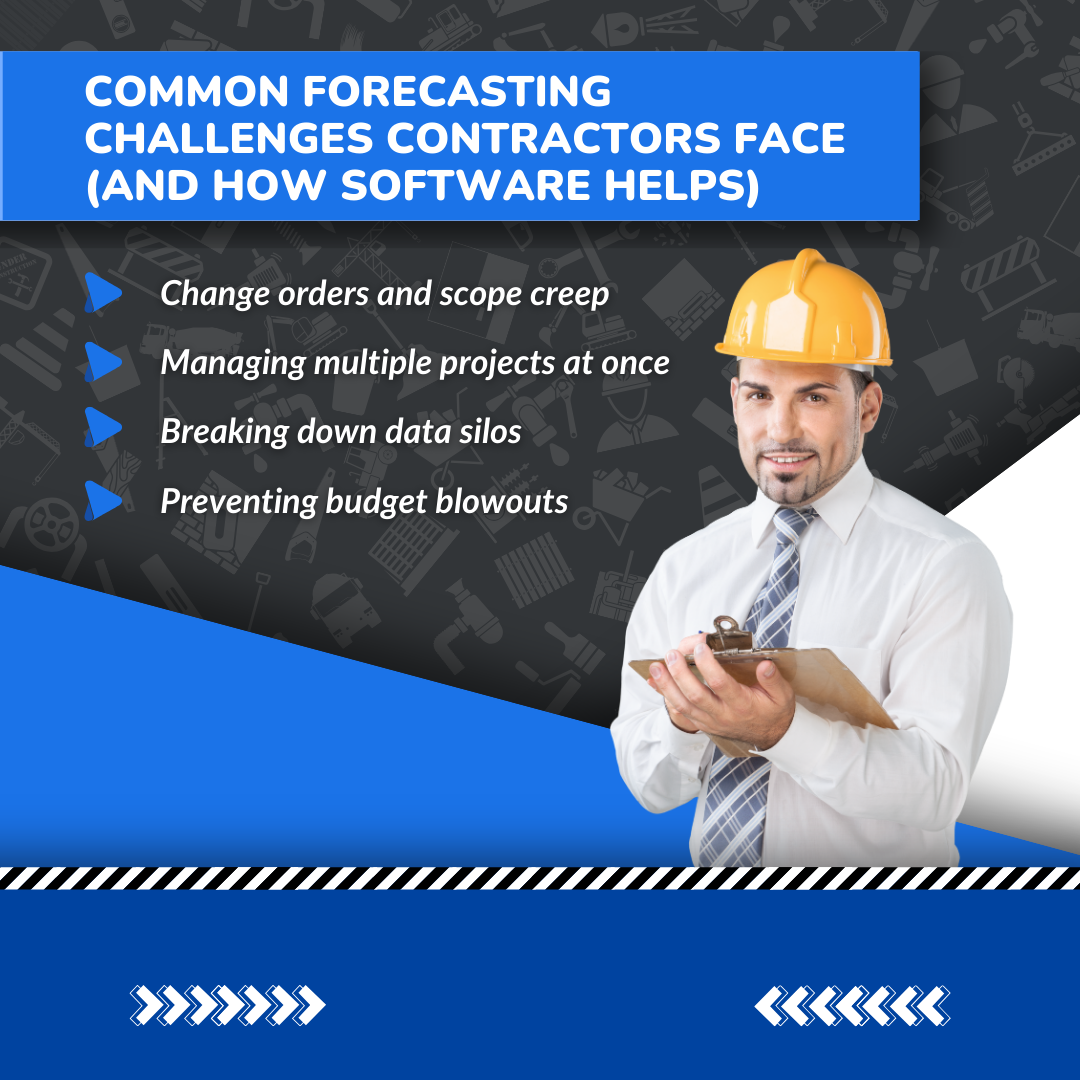
Even the best-run construction businesses hit bumps in the road. Forecasting can be tricky, and challenges like scope creep or data silos often derail well-laid plans. This is where modern software shines by turning those pain points into manageable processes.
1. Change orders and scope creep
We’ve all seen it happen: a client requests changes mid-project, and suddenly budgets and schedules are out of sync.
Forecasting software automatically recalculates impacts in real time, so project managers can see the true cost of change before it’s too late.
2. Managing multiple projects at once
For general contractors and office managers, keeping track of multiple jobs is like spinning plates; one slip, and everything comes crashing down.
In this case, centralized dashboards give a bird’s-eye view of all projects, highlighting which ones are on track and which need attention.
3. Breaking down data silos
Without software, field updates, subcontractor inputs, and accounting, reports often live in separate systems. Forecasting tools unify all this data, giving decision-makers one reliable source of truth. That means fewer mistakes and faster, more informed decisions.
4. Preventing budget blowouts
One of the biggest forecasting headaches is realizing too late that costs are spiraling. With tools like Earned Value Management (EVM), contractors can spot deviations early. It’s like a financial early-warning system, helping teams adjust course before budgets are blown.
Real-world example: A small construction business managing three mid-sized projects used forecasting software to monitor costs in real time.
The system flagged one project that was burning cash faster than expected. By reallocating resources and adjusting schedules, the company saved over $250,000 in potential overruns, a win that proved the power of proactive forecasting.
With challenges addressed, let’s now look at the benefits forecasting tools bring to the entire construction business.
Benefits of Using Forecasting Tools in Construction Project Management Software
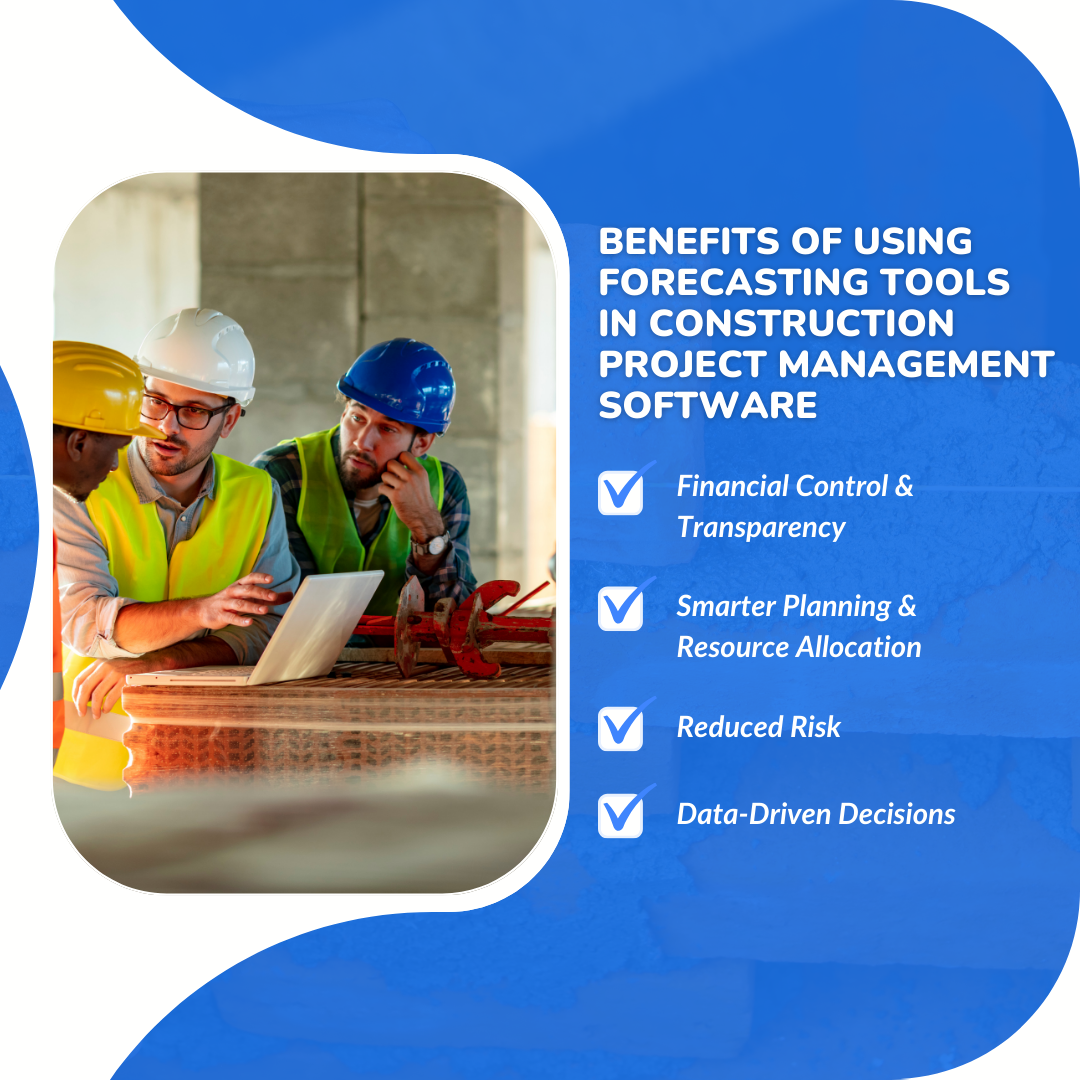
Forecasting tools do more than crunch numbers; they give construction professionals the clarity they need to manage projects with confidence. Here’s what they bring to the table:
1. Financial Control & Transparency
Accounting teams gain clear visibility into where every dollar is spent. No more guessing games, just straightforward numbers that help keep budgets on track.
2. Smarter Planning & Resource Allocation
Forecasting shows exactly where project teams, equipment, and materials should be deployed. That means fewer idle crews, fewer wasted deliveries, and smoother progress across the project lifecycle.
3. Reduced Risk
Early warnings flag potential cost overruns or schedule delays before they become major headaches. It’s like having a built-in safety net for your projects.
4. Data-Driven Decisions
Instead of relying on gut feelings, managers can adjust timelines, budgets, or resources with confidence. The result? Projects that run more efficiently lead to increased profitability.
How Forecasting Improves the Roles of Construction Professionals
Every role in a construction project comes with its own pressure: project managers chase deadlines, estimators juggle numbers, supervisors manage crews, and procurement managers time material orders.
Without solid forecasting, these priorities collide, creating stress, delays, and extra costs.
1. General Contractors & Project Managers
No more waking up at 3 AM wondering if the project will blow its budget. With accurate forecasting, contractors and project managers can see how timelines, costs, and project documents line up in real time.
That means fewer surprises, smoother back office operations, and more time spent leading teams instead of putting out fires.
2. Estimators & Financial Officers
Estimators no longer have to feel like fortune tellers with a calculator. Forecasting software combines historical data, accounting tools, and real-time updates to make cost predictions far more accurate.
Financial officers, in turn, gain the clarity they need to keep profitability on track, and maybe even enjoy their coffee while it’s still hot.
3. Site Supervisors & Planners
On the field, resources are everything. Forecasting ensures supervisors know exactly when labor, equipment, or subcontractors are needed.
No more idle crews waiting around for materials that didn’t arrive on time, or scrambling because too many workers showed up for too little work. It’s about balance and keeping projects moving like a well-oiled machine.
4. Procurement Managers
Forget the “order now, pay later” approach. With forecasting, procurement managers can align material orders with project schedules, ensuring deliveries happen just in time, not too early, not too late.
This means less cash tied up in excess inventory and fewer costly delays when supplies run short. Plus, it spares them from the dreaded phone calls asking, “Where are the materials?”
At the end of the day, forecasting doesn’t just help manage projects; it helps manage stress levels across the entire construction business.
From office managers crunching numbers to builders on the jobsite, everyone gets the gift of foresight (and maybe even a full night’s sleep).
Explore more: Training Your Team to Maximize Construction CRM Benefits
Practical Steps to Implement Forecasting Software Successfully
Rolling out forecasting software isn’t just about plugging in a new tool; it’s about making sure everyone knows how to use it and trusts the data it provides. Here’s how to set yourself up for success:
1. Set Clear Baselines & Work Breakdown Structure (WBS)
Start with a well-defined project scope, timeline, and cost baseline. A clear WBS ensures every task is accounted for, so forecasts aren’t built on guesswork.
2. Train Users and Teams
Project managers, office managers, and subcontractors should understand how to track and interpret forecasting metrics. Even a quick training session can prevent missteps and boost confidence in the system.
3. Review Forecasts Regularly
Update forecasts weekly or monthly to keep them accurate. Small, consistent reviews help spot risks early—before they snowball into delays or budget overruns.
4. Encourage Open Communication
Forecasting works best when field teams and back-office staff share updates freely. Simple practices like daily logs or shared dashboards help everyone stay aligned, and projects move smoothly.
How ConstructionBase Solves Forecasting Challenges
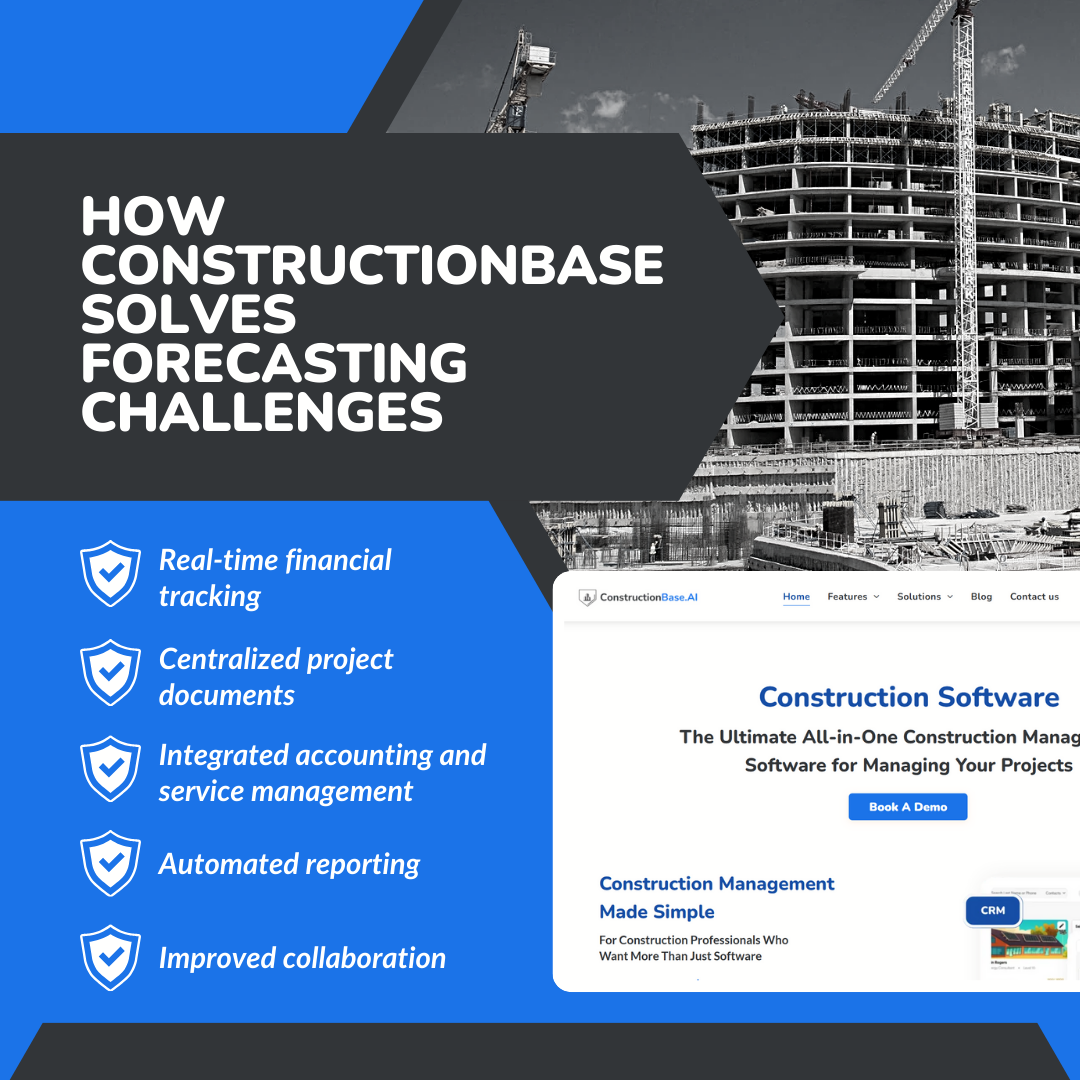
For many contractors, forecasting often feels like juggling in the dark. You’ve got cost estimates in one spreadsheet, subcontractor updates buried in emails, accounting in another software, and project documents spread across folders. By the time everything comes together, deadlines are already slipping, and budgets are off track.
ConstructionBase steps in as the all-in-one solution designed specifically for the construction business. Instead of relying on disconnected tools, contractors, office managers, and project teams can manage every stage of the project lifecycle in one streamlined system.
Here’s how ConstructionBase makes forecasting easier and more reliable:
1. Real-time financial tracking
Continuously tracks planned vs. actual costs across labor, materials, and equipment. Automated variance alerts flag when expenses start exceeding projections, helping teams take corrective action before small issues become costly overruns.
2. Centralized project documents
Keep schedules, contracts, and subcontractor updates in one place so nothing gets lost in back-and-forth communication.
3. Integrated accounting and service management
Sync financial data with forecasting tools for accurate cost-to-complete reports. This integration enables accurate cost-to-complete calculations, cash flow forecasting, and WIP (work-in-progress) reporting.
4. Automated reporting
Generate clear, data-driven forecasts that highlight risks and give managers actionable insights. These reports use historical performance data, productivity trends, and cost burn rates to build forward-looking projections, making forecasting faster and more evidence-based.
5. Improved collaboration
From office managers and estimators to field supervisors and subcontractors, everyone works from the same page.
6. Customizable dashboards & Custom KPIs
Let's teams configure forecasting dashboards to show their most critical financial, schedule, and performance metrics. Custom KPIs highlight leading indicators of risk before they affect project outcomes.
7. Automated estimating & scheduling
This feature connects time + cost data in one system, which gives contractors a clear forward-looking view of budget, resource demand, and deadlines, all critical for accurate forecasting.
8. Takeoff & Bidding
The takeoff and bidding feature turns early project data into predictive insights on cost, workload, and profitability, enabling contractors to forecast resources, revenue, and risk well before contracts are signed.
For small construction businesses, this means less time buried in back office operations and more time focusing on building.
For larger construction companies, it means gaining the visibility needed to improve cash flow, streamline service management, and ensure projects remain profitable.
In short, ConstructionBase doesn’t just help contractors manage projects; it gives them the confidence to forecast with accuracy, make smarter decisions, and build stronger client trust.
Conclusion: Take Control of Your Project’s Future
Forecasting isn’t just a financial exercise; it’s peace of mind. With construction project management software, contractors can save money, reduce delays, and boost profits.
The right tools help general contractors, estimators, project managers, office managers, and site supervisors move from constant firefighting to confident project delivery.
If you want to stop budget blowouts and gain control of your construction projects, now is the time to embrace modern forecasting software. It’s not just a tool, it’s a game-changer for the construction industry.
About ConstructionBase
ConstructionBase is built specifically for contractors, project managers, and construction teams looking to improve efficiency, control costs, and boost profits.
From project tracking and job costing to forecasting, accounting, and cash flow management, our integrated solutions keep your back office and field teams on the same page, so you can focus on building success.
Ready to give the whole team a clear map instead of scattered directions? Contact ConstructionBase today!
FAQs
1: What features should I look for in forecasting software?
Look for integrated budgeting, scheduling, document management, service management, and real-time reporting.
2: Can forecasting software handle change orders in real time?
Yes, modern construction project management software updates forecasts instantly when change orders are logged.
3: How accurate is earned value management in predicting budget issues?
When combined with real-time data, EVM is highly reliable for spotting risks early in the project lifecycle.
4: How often should forecasts be updated?
Weekly for active construction projects, monthly for long-term oversight.
Have questions or need personalized advice?
Talk to an Expert Today and let our construction specialists guide you to success.







